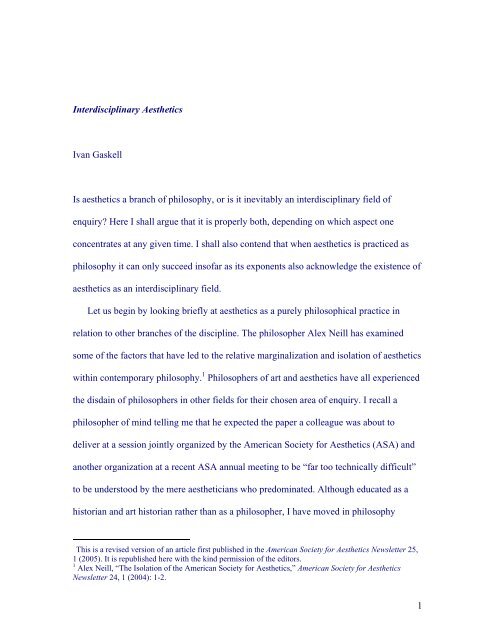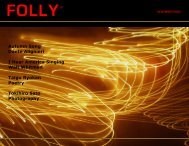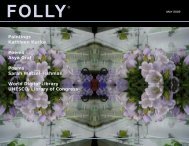1 Interdisciplinary Aesthetics Ivan Gaskell Is aesthetics a ... - Folly
1 Interdisciplinary Aesthetics Ivan Gaskell Is aesthetics a ... - Folly
1 Interdisciplinary Aesthetics Ivan Gaskell Is aesthetics a ... - Folly
Create successful ePaper yourself
Turn your PDF publications into a flip-book with our unique Google optimized e-Paper software.
<strong>Interdisciplinary</strong> <strong>Aesthetics</strong><br />
<strong>Ivan</strong> <strong>Gaskell</strong><br />
<strong>Is</strong> <strong>aesthetics</strong> a branch of philosophy, or is it inevitably an interdisciplinary field of<br />
enquiry? Here I shall argue that it is properly both, depending on which aspect one<br />
concentrates at any given time. I shall also contend that when <strong>aesthetics</strong> is practiced as<br />
philosophy it can only succeed insofar as its exponents also acknowledge the existence of<br />
<strong>aesthetics</strong> as an interdisciplinary field.<br />
Let us begin by looking briefly at <strong>aesthetics</strong> as a purely philosophical practice in<br />
relation to other branches of the discipline. The philosopher Alex Neill has examined<br />
some of the factors that have led to the relative marginalization and isolation of <strong>aesthetics</strong><br />
within contemporary philosophy. 1 Philosophers of art and <strong>aesthetics</strong> have all experienced<br />
the disdain of philosophers in other fields for their chosen area of enquiry. I recall a<br />
philosopher of mind telling me that he expected the paper a colleague was about to<br />
deliver at a session jointly organized by the American Society for <strong>Aesthetics</strong> (ASA) and<br />
another organization at a recent ASA annual meeting to be “far too technically difficult”<br />
to be understood by the mere aestheticians who predominated. Although educated as a<br />
historian and art historian rather than as a philosopher, I have moved in philosophy<br />
This is a revised version of an article first published in the American Society for <strong>Aesthetics</strong> Newsletter 25,<br />
1 (2005). It is republished here with the kind permission of the editors.<br />
1<br />
Alex Neill, “The <strong>Is</strong>olation of the American Society for <strong>Aesthetics</strong>,” American Society for <strong>Aesthetics</strong><br />
Newsletter 24, 1 (2004): 1-2.<br />
1
circles long enough to be discomforted by such sentiments. After all, not only is<br />
<strong>aesthetics</strong> as intellectually challenging as any human being can dare to make it, but most<br />
of us concerned with it have to be, and indeed wish to be, at least competent, and ideally<br />
excellent, in other, more reputedly muscular branches of philosophy. Furthermore, the<br />
partitions dividing areas of intellectual endeavor are far from impermeable, so<br />
philosophers cannot practice <strong>aesthetics</strong> in mental isolation from their other concerns. We<br />
all know, then, that the disdain of specialists in other philosophical fields is misplaced.<br />
Nonetheless, Neill’s point that aestheticians need to take the initiative in cultivating<br />
contacts with them is well taken.<br />
Surely Neill is also correct when he expresses fear that the development of <strong>aesthetics</strong><br />
as an independent discipline, which he ascribes to several of the founding fathers of the<br />
ASA as their ideal, would lead to its estrangement from philosophy more generally. Yet<br />
just as dangerous for our capacity to think creatively as any fissure of <strong>aesthetics</strong> from the<br />
rest of philosophy, is our acquiescence in, or even encouragement of, fissiparous<br />
tendencies within <strong>aesthetics</strong> itself. When proponents of analytical ideals and advocates of<br />
continental theories no longer converse constructively with one another, all are losers.<br />
The philosopher Casey Haskins has eloquently argued that <strong>aesthetics</strong> “exhibits an<br />
identifying integrity not in spite of, but on account of, the divergent ways in which its<br />
participants talk or write.” 2 Its very disunity, rather than any pretended coherence, is its<br />
strength, for this allows <strong>aesthetics</strong> to function as a network in which filaments can<br />
occasionally reticulate in unlikely yet productive ways: Kristeva, Lacan, and Kant<br />
appealed to in the same breath, for instance. Haskins points to the Oxford Encyclopedia<br />
2<br />
Casey Haskins, “The Disunity of <strong>Aesthetics</strong>: A Response to J.G.A. Pocock,” Common Knowledge 11, 2,<br />
2005.<br />
2
of <strong>Aesthetics</strong>, edited by Michael Kelly, as the cynosure of a practice of <strong>aesthetics</strong> that<br />
values, as he puts it, “not simply knowledge that comes from collaborations among<br />
researchers who share vocabularies, methodologies, and even ideologies, but also<br />
knowledge that comes from interactions and confrontations among colleagues who do not<br />
recognize the legitimacy of one another’s work.”<br />
<strong>Aesthetics</strong> thrives not only when it is internally connected (however various and<br />
mutually antipathetic its constituents), and when it is connected with other fields of<br />
philosophy, but also with other areas of enquiry and professional practice, notably but not<br />
exclusively the critical disciplines of the human sciences. The fact that the ASA is “an<br />
association for <strong>aesthetics</strong>, criticism, and theory of the arts,” and that its journal is not only<br />
of <strong>aesthetics</strong> but also of art criticism, should remind us of the advantages of permeability<br />
among fields not only within philosophy, but between philosophy and the critical<br />
disciplines. Further, the editorial statement of the online journal, Contemporary<br />
<strong>Aesthetics</strong>, launched in 2003 under the editorship of Arnold Berleant, states, “In recent<br />
years <strong>aesthetics</strong> has grown into a rich and varied discipline. Its scope has widened to<br />
embrace ethical, social, religious, environmental, and cultural concerns. As international<br />
communication increases through more frequent congresses and electronic<br />
communication, varied traditions have joined with its historically interdisciplinary<br />
character, making <strong>aesthetics</strong> a focal center of diverse and multiple interests.” 3 I propose<br />
that we read these rubrics not as calls for <strong>aesthetics</strong> to be an independent discipline at a<br />
distance from philosophy more generally, but rather as calls for <strong>aesthetics</strong> to be a<br />
collaborative project that benefits not only from substantive exchanges within<br />
3 http://www.contemp<strong>aesthetics</strong>.org/.<br />
3
philosophy, but also with practitioners from other disciplines ranging across the alphabet<br />
from anthropology to zoology.<br />
In proposing that <strong>aesthetics</strong> not only benefits from interdisciplinary exchange, but that<br />
it must necessarily be pursued in the light of interdisciplinary concerns, I should like to<br />
apply the principle of aspect viewing to <strong>aesthetics</strong>. Clearly, not only does <strong>aesthetics</strong> admit<br />
numerous interpretations of its objects of study, but the field itself is amenable to more<br />
than one interpretation. For instance, sometimes we might legitimately see it as a branch<br />
of philosophy, while at others we might see it, rather, as defined by the intersection of<br />
various disciplines, philosophy among them. In this respect, <strong>aesthetics</strong> is like Ludwig<br />
Wittgenstein’s famous ambiguous image that can be seen alternately as a duck and as a<br />
rabbit (Fig. 1). 4 Let us suppose the disciplinary equivalent of the image as a duck to be<br />
<strong>aesthetics</strong> as a specialist field within a particular discipline: <strong>aesthetics</strong>, that is, as a sub-<br />
discipline of philosophy. Much is to be gained from the focus afforded by the progressive<br />
concentration upon philosophical questions peculiar to the field as aestheticians refine<br />
them from others specific to philosophy more generally. We can take the equivalent of<br />
the image as a rabbit, on the other hand, to be <strong>aesthetics</strong> as an interdisciplinary endeavor.<br />
As such, it is a mode of enquiry no less dependent upon the critical disciplines than on<br />
distinctively philosophical procedures. We cannot do both simultaneously—pursue<br />
<strong>aesthetics</strong> as pure philosophy, and as interdisciplinary combination—just as we cannot<br />
4 Ludwig Wittgenstein, Philosophical Investigations, the German text, with a revised English translation,<br />
3 rd ed., trans. G.E.M. Anscombe (Oxford: Blackwell, 2001), II, xi, 165-67 (1 st edn. 1953), attributes the<br />
prototype of his simplified line drawing to Joseph Jastrow, Fact and Fable in Psychology (Boston:<br />
Houghton, Mifflin, 1900) although Jastrow had published it the previous year in his article, “The Mind’s<br />
Eye,” Popular Science Monthly 54, 1899, 299-312; whereas E.H. Gombrich, Art and Illusion: A Study in<br />
the Psychology of Pictorial Representation, 5 th edn. (London: Phaidon, 1977), 4-5 (1 st edn. 1960), who in<br />
his discussion of the image cites the first edition of Wittgenstein, ascribes it to “the humorous weekly Die<br />
Fliegenden Blätter” (published in Munich between 1845 and 1944) as reproduced by Norma V.<br />
Scheidemann, Experiments in General Psychology, enlarged edn. (Chicago: University of Chicago Press,<br />
1939), 67, fig. 21 (1 st edn. 1929).<br />
4
see the duck and rabbit other than as alternatives to one another. Whereas in his<br />
discussion of the image, Ernst Gombrich adheres to a purely binary conception of the<br />
perceptual process concerned—“the more closely we watch ourselves, the more certainly<br />
will we discover that we cannot experience alternative readings at the same time”—<br />
Wittgenstein conceives of our perception of both aspects as itself being affected by<br />
alternating between them: “The expression of a change of aspect is the expression of a<br />
new perception and at the same time of the perception’s being unchanged.”<br />
Wittgenstein’s claim would seem to promise a great deal for <strong>aesthetics</strong>, for while it might<br />
be productive in various respects either to pursue <strong>aesthetics</strong> as philosophy alone, or to<br />
pursue <strong>aesthetics</strong> as an interdisciplinary endeavor, to see both of these courses of action<br />
necessarily affecting one another as a condition of pursuing either satisfactorily would<br />
surely be an advance on simply making a choice to follow one or the other exclusively. In<br />
other words, however purely and exclusively philosophical one wishes to be in making<br />
aesthetic enquiries, one cannot wholly ignore the claims of other disciplines, just as one<br />
cannot not be aware of the existence of the rabbit aspect of the duck-rabbit image when<br />
one concentrates on the duck aspect once one knows the latter to be a possible<br />
interpretation. To see only the duck aspect would be either a failure of perception or a<br />
culpably willful suppression. By any reckoning, then, <strong>aesthetics</strong> must be an<br />
interdisciplinary endeavor, whether one chooses to pursue it as such, or to eschew other<br />
disciplinary concerns as far as possible in favor of purely philosophical matters. This is<br />
not to claim that some people’s practice of <strong>aesthetics</strong> cannot quite properly be<br />
preponderantly philosophical—duck-like—only that that very ducklikeness is necessarily<br />
affected by the philosopher’s knowledge of the existence of rabbitlikeness—the concerns<br />
5
of other disciplines—and, if that philosophy is to be cogent and to sustain critical<br />
scrutiny, it cannot ignore every consequence of the existence of those rabbitlike concerns.<br />
What, then, is the broader consequence of this claim? Sadly, it is that philosophers<br />
who broach aesthetic issues in ignorance of the proper concerns—procedures and<br />
information—of those in other disciplines that discuss the same material must fail.<br />
Perhaps it is a consolation to philosophers that the same holds true in the other direction:<br />
that those in the critical disciplines who discuss <strong>aesthetics</strong> in ignorance of philosophy<br />
germane to their concerns will also fail. Philosophy and the critical disciplines are not<br />
alternative epistemological modes, the one as good as the other in some relative manner.<br />
The claims each one makes either satisfy scrutiny from the other disciplinary point of<br />
view, however secondary it may be in any given instance, or they do not. (We must, of<br />
course, resist the temptation of claiming that philosophy is a metadiscipline whose<br />
preoccupations and procedures trump those of all other disciplines. It simply cannot be<br />
conducted successfully in ignorance of the lessons of other disciplines. Neither does<br />
philosophy comprehend all useful thought.)<br />
We are left with the conclusion that, however apparently philosophically exclusive<br />
any given pursuit of <strong>aesthetics</strong> may be—and it is clearly quite proper to pursue <strong>aesthetics</strong><br />
as a branch of philosophy—the very fact that it is amenable to pursuit in an explicitly<br />
interdisciplinary manner entails modification of the first alternative such as to render it<br />
implicitly interdisciplinary, just as the second alternative must be rendered implicitly<br />
philosophical. Neither aspect of <strong>aesthetics</strong>—the purely philosophical and the<br />
interdisciplinary—can properly exist wholly independent of the other wherever one<br />
chooses to expend one’s effort.<br />
6
I hope to have demonstrated, first, that <strong>aesthetics</strong> is always at the very least implicitly<br />
interdisciplinary, and, second, that in spite of being so one can pursue it from within<br />
philosophy, although in that case it would be greatly to the advantage of everyone<br />
interested in <strong>aesthetics</strong> to do so on a broad intellectual front. This is not to claim that<br />
everyone in <strong>aesthetics</strong> must master every pertinent contributory discipline: that would be<br />
unrealistic and absurd. Yet if the claims that philosophers make in the realm of <strong>aesthetics</strong><br />
are to find a wider audience, and thus to inform thought more generally, those claims<br />
must be plausible to practitioners of other disciplines who also make claims about the<br />
same or similar topics.<br />
For example, the later paintings of Piet Mondrian are amenable to discussion in terms<br />
of two-dimensional, rectilinear patterns, and anyone is free to discuss them as such. This<br />
may be one of their most interesting characteristics amenable to aesthetic consideration<br />
by philosophers. However, any such consideration that fails to take into account other<br />
characteristics of these paintings, such as their three-dimensionality, as manifested by<br />
their supports, layering of paints, revisions, surface facture, development of craquelure,<br />
may seem to be no more than a discussion of abstractions from the paintings—derivative<br />
artifacts, no less—rather than of the paintings themselves. 5 Such discussion is open to the<br />
suspicion that the selection of Mondrian’s patterns for consideration in isolation from<br />
their actual material embodiment, was made in ignorance of the possible roles—or even<br />
existence—of the neglected features, rather than as the result of informed choice. This is<br />
not to claim that the salient feature of these works for a particular aesthetic discussion<br />
5 For instance, compare John Brown, “Mondrian’s Balance” posted at<br />
http://www.philosophy.umd.edu/Faculty/jhbrown/mondriansbalance/index.html, with Ron Spronk,<br />
“Revealing Revisions: The Transatlantic Paintings in the Laboratory,” in Harry Cooper and Ron Spronk,<br />
Mondrian: The Transatlantic Paintings (Cambridge, MA: Harvard University Art Museums, and New<br />
Haven and London: Yale University Press, 2001), 67-106.<br />
7
may not legitimately be their patterns, but in an important sense any such discussion in<br />
isolation is likely to fail a test of interdisciplinary adequacy.<br />
It is worth reiterating that interdisciplinarity is a matter of exchange, not correction.<br />
Practitioners of human science disciplines have much to learn from the precision of<br />
argument and marshalling of abstractions that aestheticians and other philosophers bring<br />
to their topics. The ASA is the ideal forum for such exchanges, not only within <strong>aesthetics</strong><br />
and within philosophy more generally, but also among philosophers and exponents of<br />
other disciplines. To foster such exchanges would not only accord expediently with many<br />
of the demands being made on us within our institutions to collaborate across disciplinary<br />
boundaries in research and teaching, but would bring innumerable intellectual and even<br />
affective benefits, as well as constituting an active and practical acknowledgement of the<br />
necessarily interdisciplinary character of <strong>aesthetics</strong>.<br />
Fig. 1 Duck-Rabbit Illusion, from: Joseph Jastrow, “The Mind’s Eye,” Popular Science<br />
Monthly 54, 1899, 299-312. Media file in the public domain.<br />
http://commons.wikimedia.org/wiki/index.html?curid=667017<br />
8




